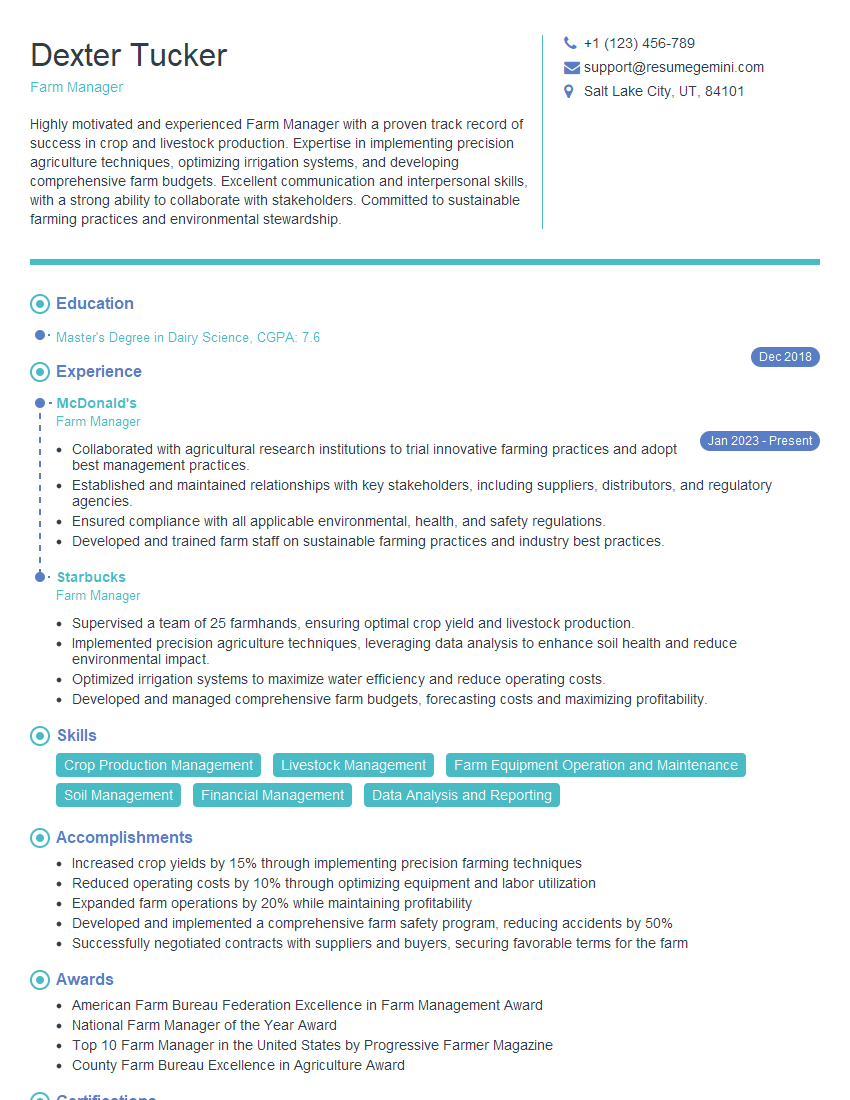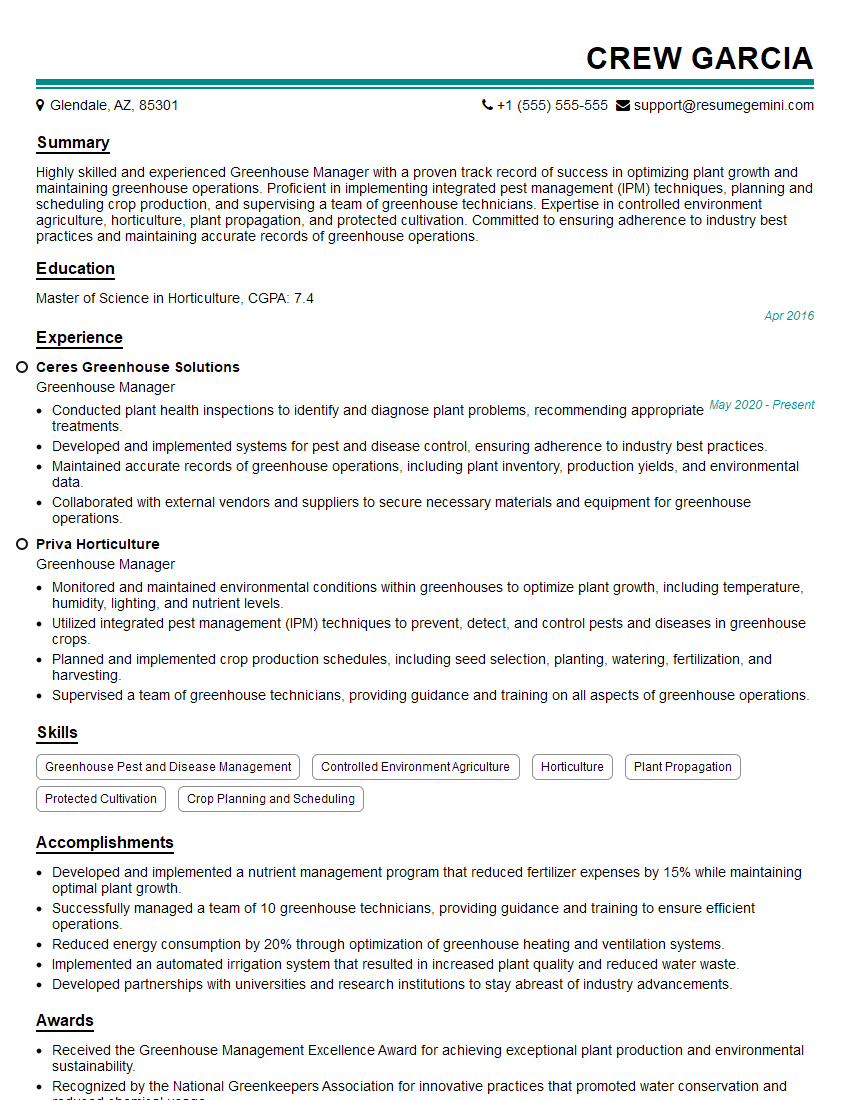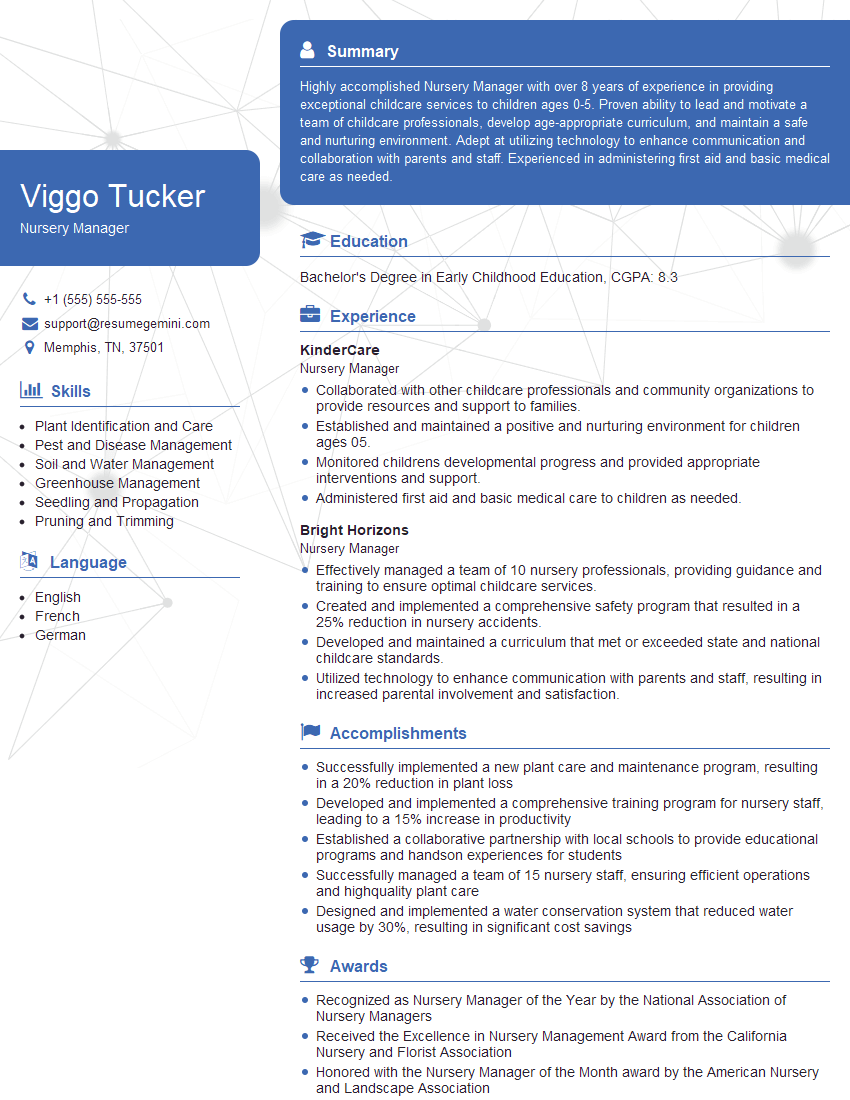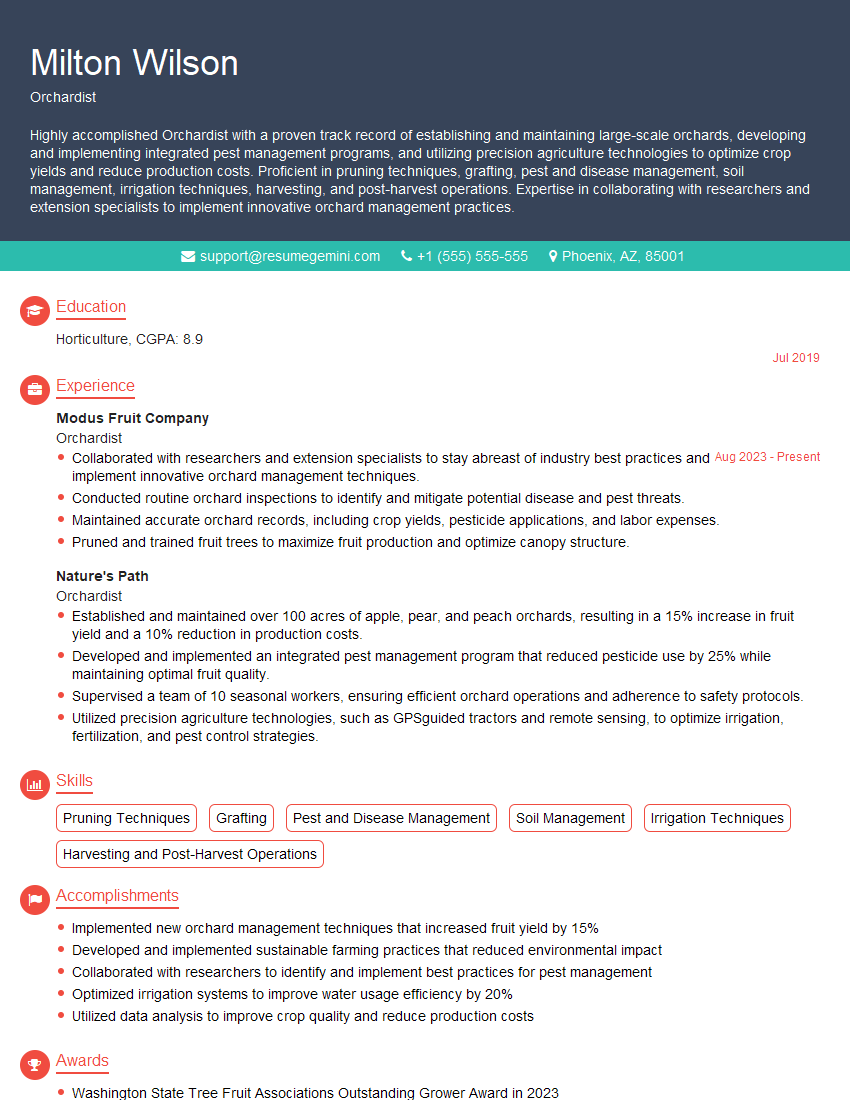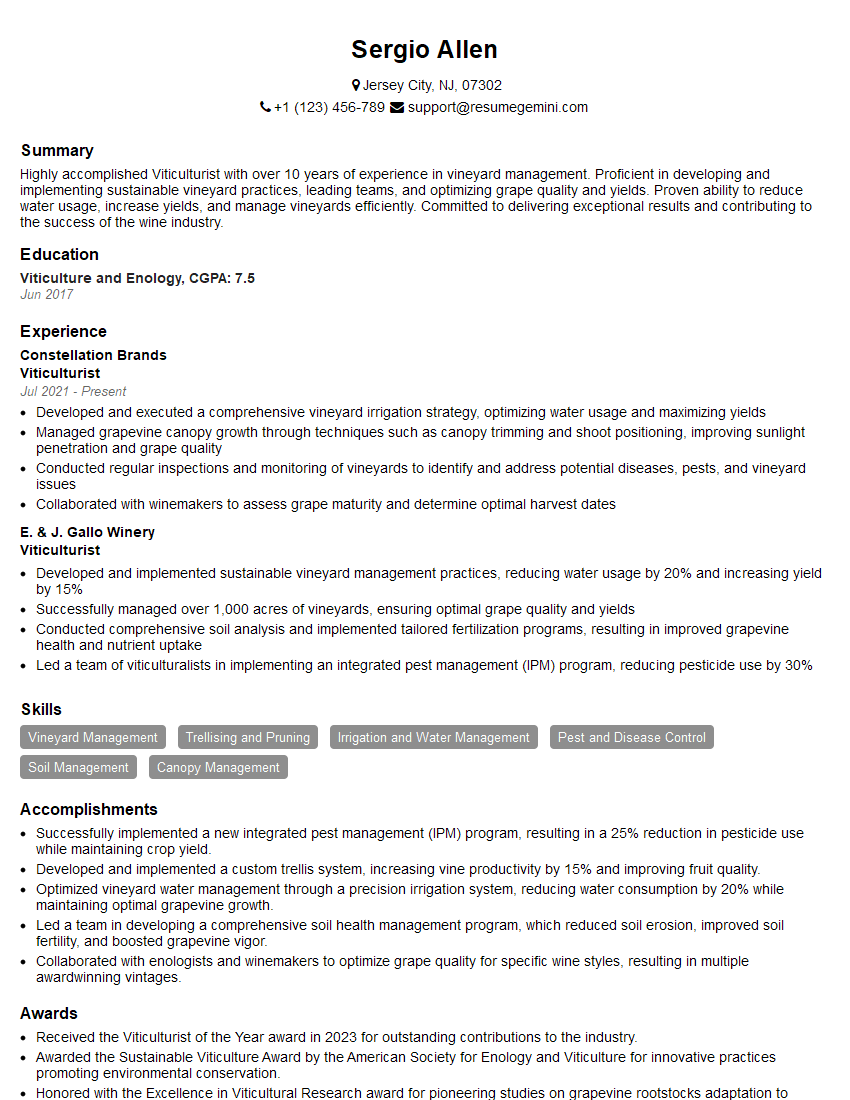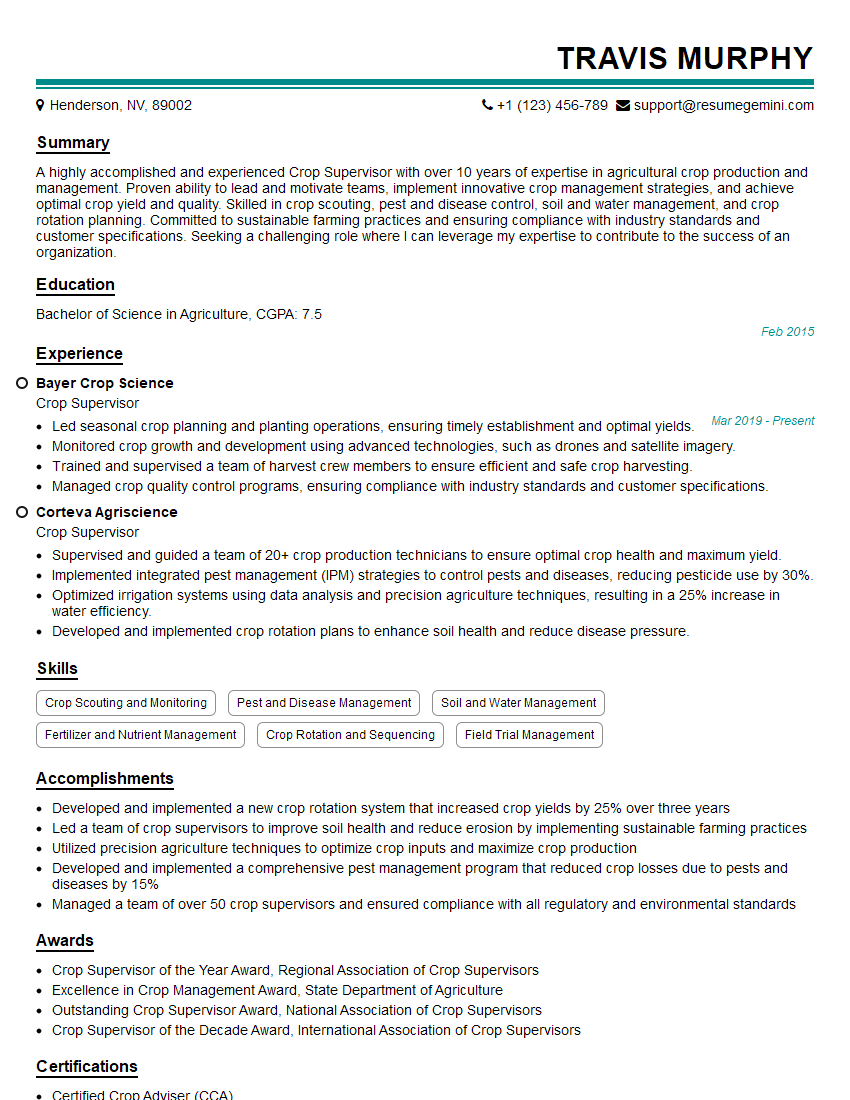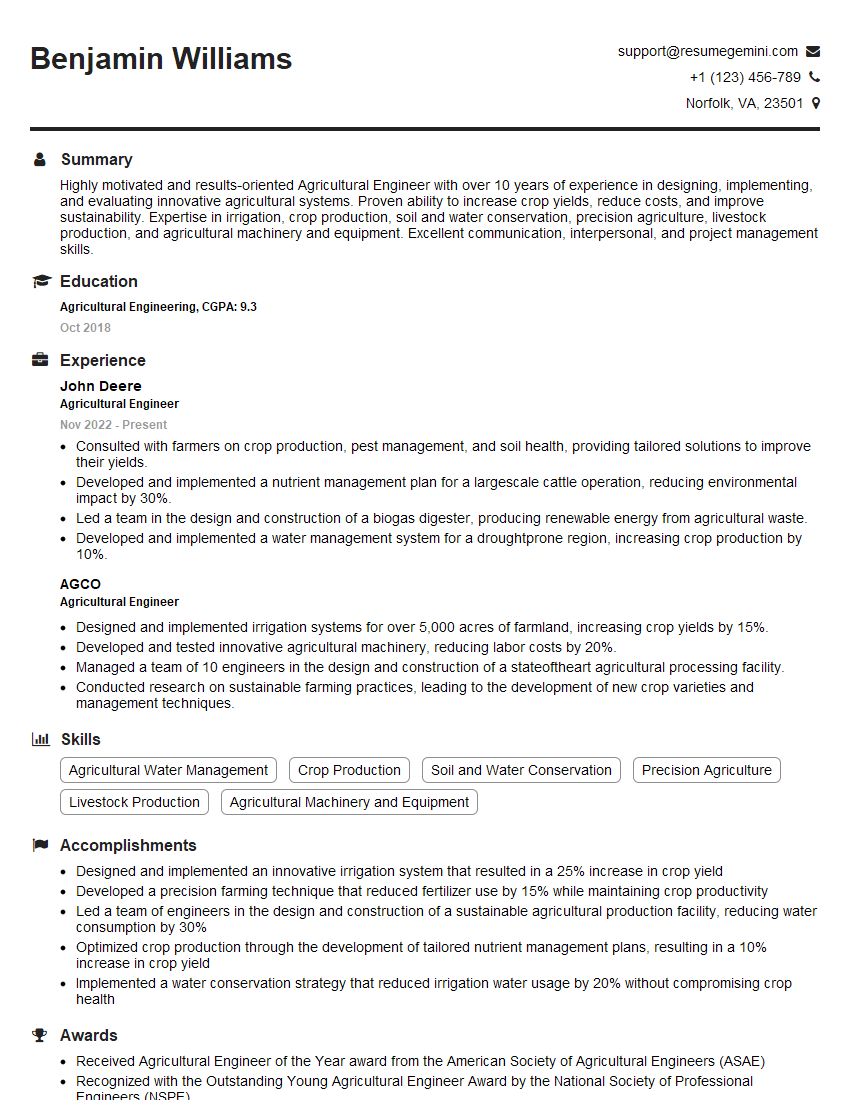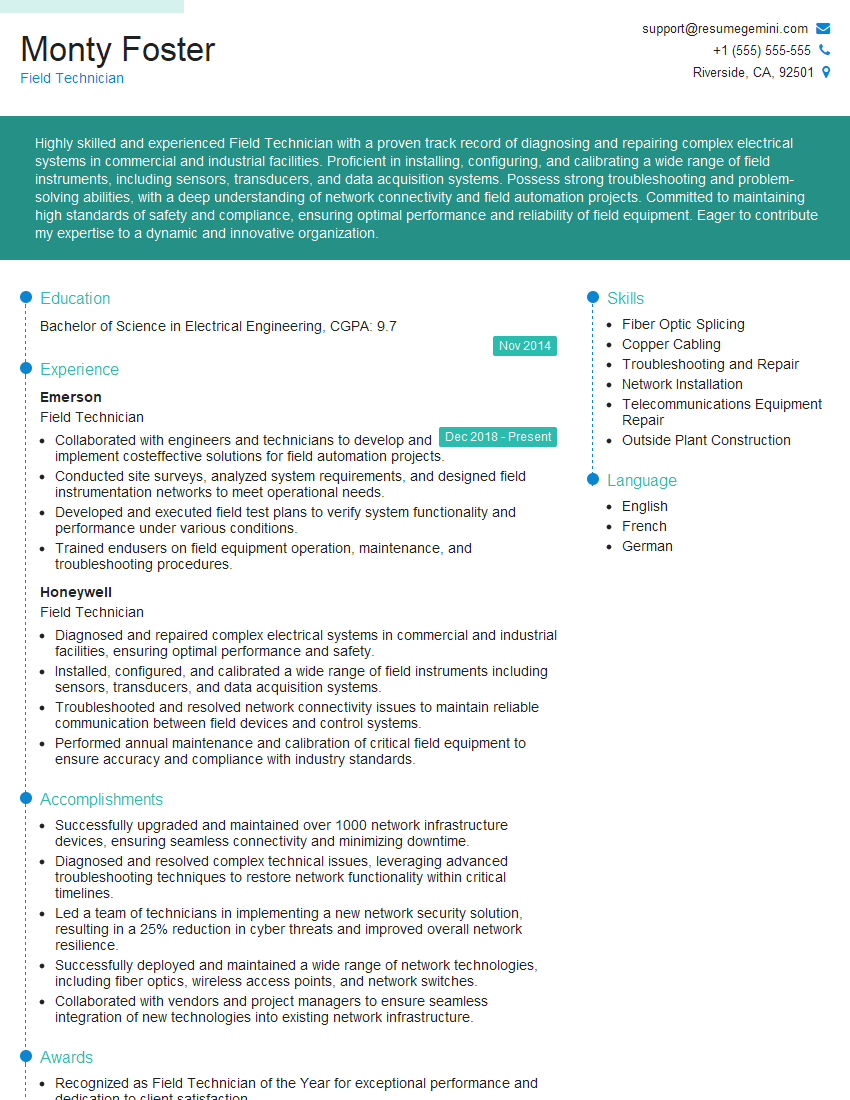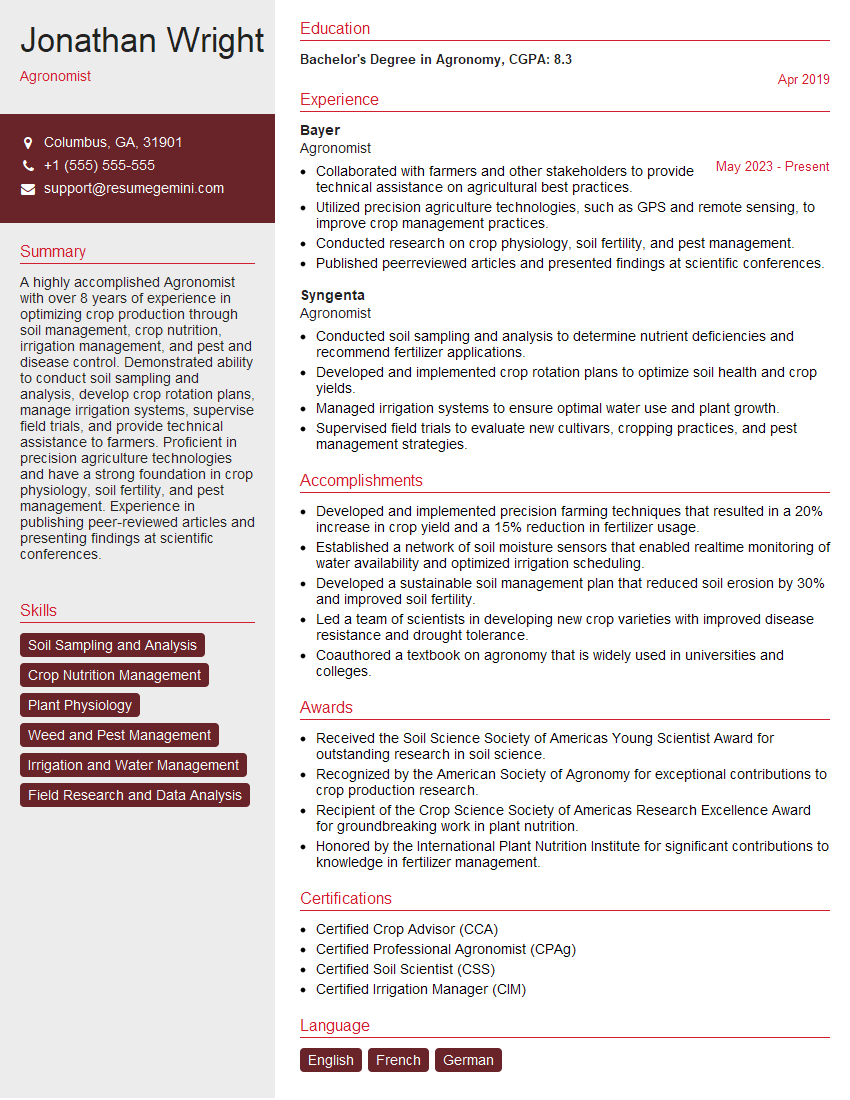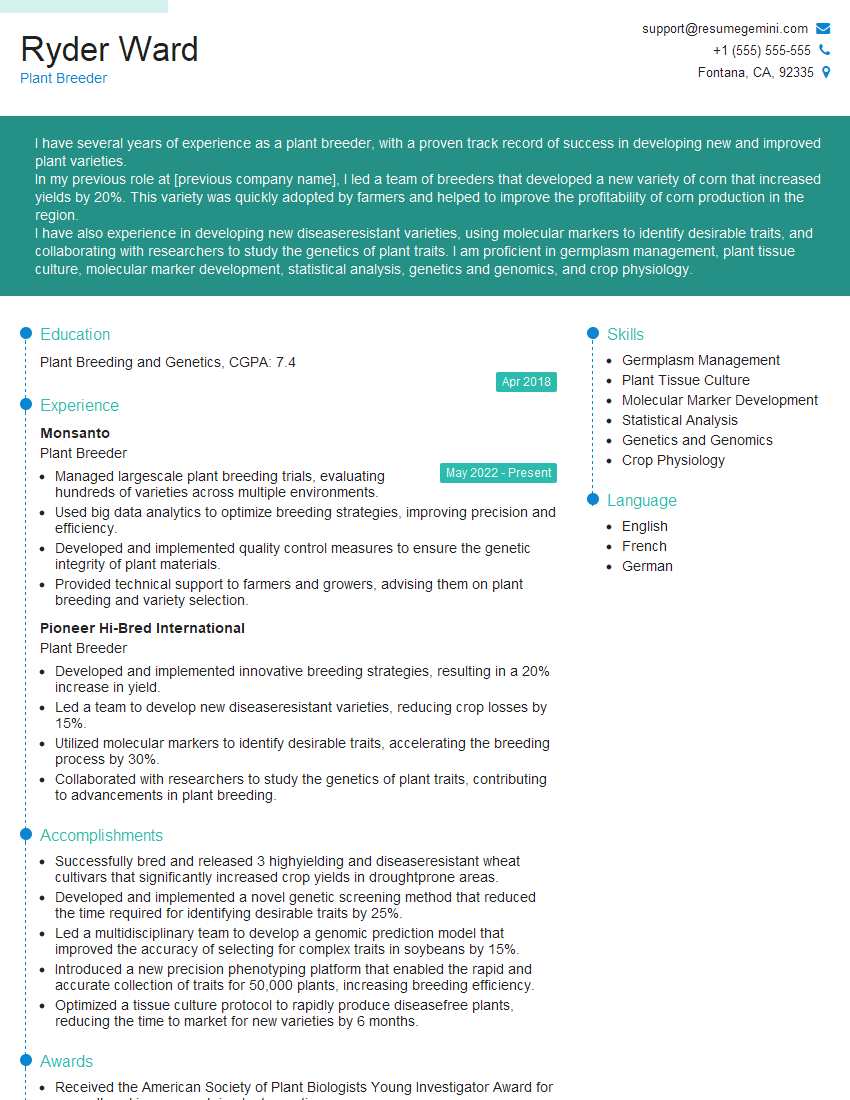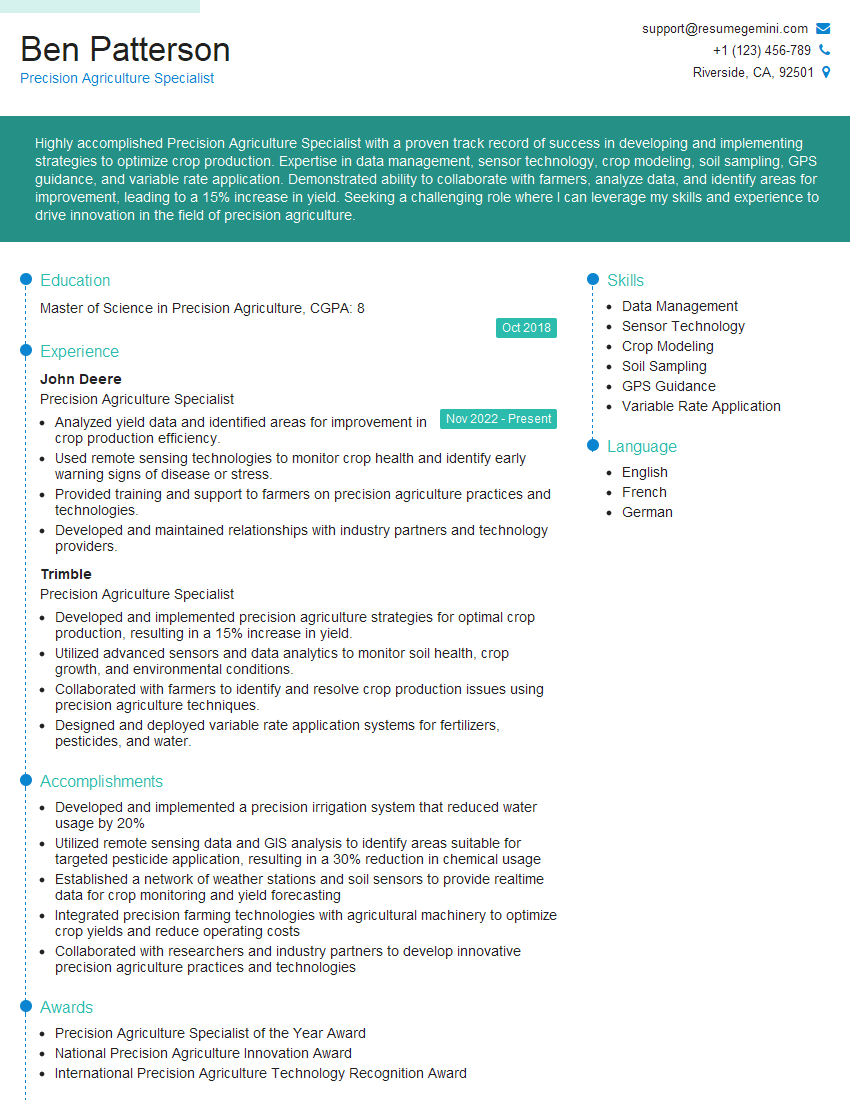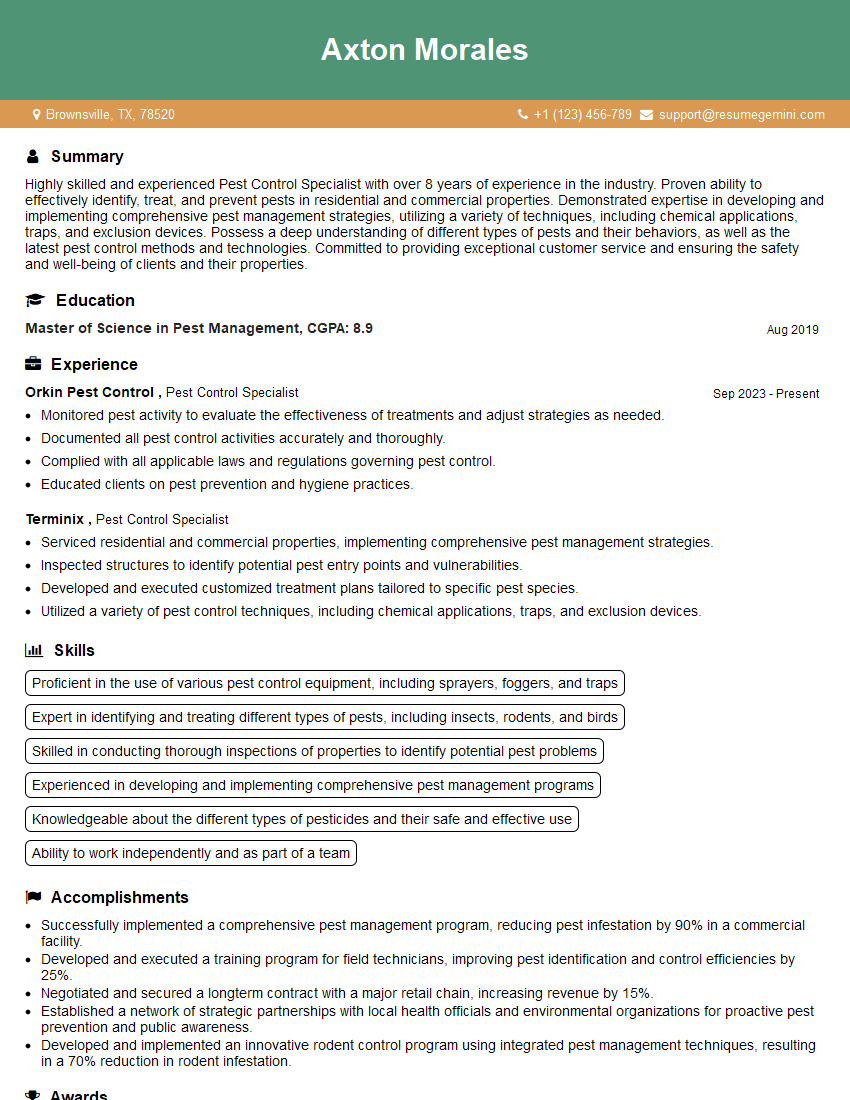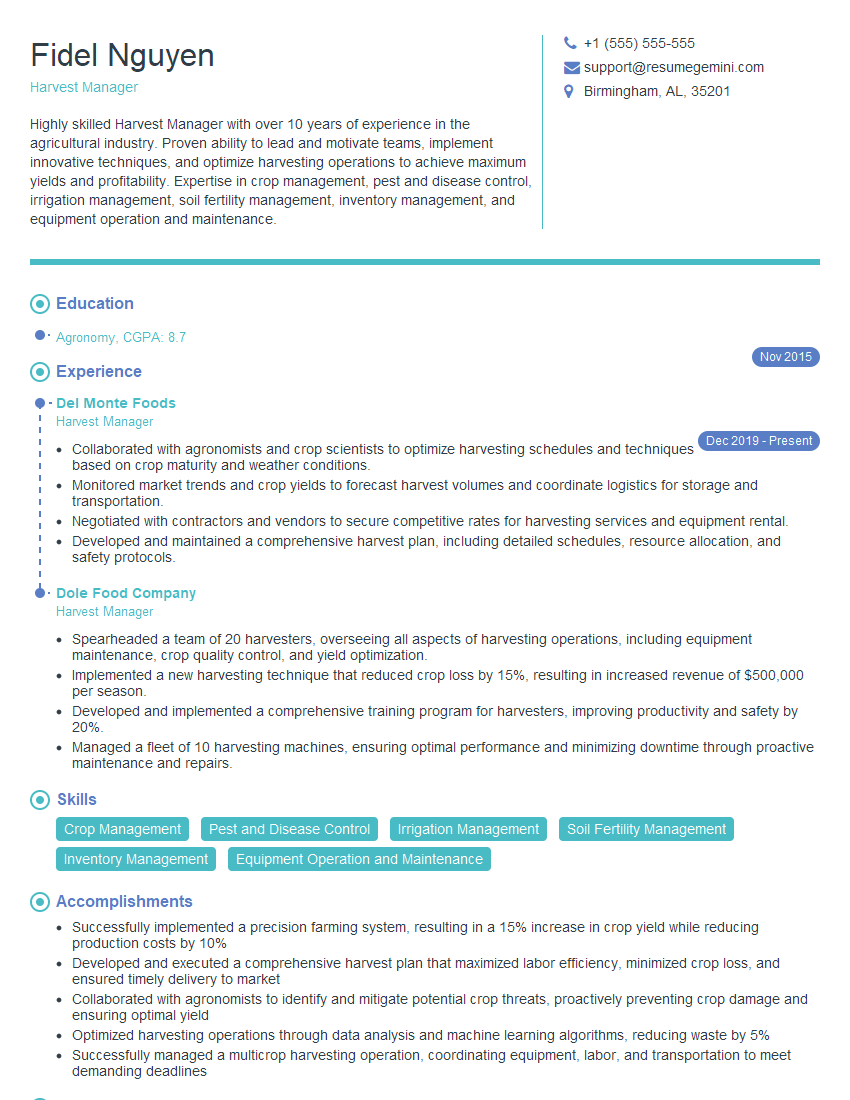Are you ready to stand out in your next interview? Understanding and preparing for Cultivation and Harvesting interview questions is a game-changer. In this blog, we’ve compiled key questions and expert advice to help you showcase your skills with confidence and precision. Let’s get started on your journey to acing the interview.
Questions Asked in Cultivation and Harvesting Interview
Q 1. Describe your experience with different soil types and their impact on crop cultivation.
Soil type is paramount in successful cultivation. Different soils offer varying levels of nutrients, water retention, drainage, and aeration, all directly impacting crop growth. My experience spans working with sandy soils, clay soils, loamy soils, and peat soils. Sandy soils, for example, drain quickly, requiring more frequent irrigation but offering excellent aeration. Conversely, clay soils retain water well but can become compacted, hindering root development. Loamy soils, a mixture of sand, silt, and clay, are often ideal, offering a balance of drainage and water retention. Peat soils, rich in organic matter, provide excellent nutrient content but can be acidic and require careful pH management.
In my work, I’ve learned to tailor cultivation practices to the specific soil type. For instance, I’ve implemented no-till farming techniques in clay soils to prevent compaction, and used cover crops in sandy soils to improve water retention. Soil testing is crucial; it informs the precise fertilization needs for each soil type, maximizing nutrient uptake and minimizing environmental impact.
Q 2. Explain your understanding of various irrigation techniques and their efficiency.
Irrigation is vital for consistent crop yields. I’m proficient in various techniques, each with its pros and cons regarding efficiency and water usage. Drip irrigation, for example, delivers water directly to plant roots, minimizing evaporation and runoff, making it highly efficient. However, it can be expensive to install and maintain. Sprinkler irrigation is more cost-effective but can lead to higher evaporation and water waste, particularly in windy conditions. Flood irrigation is the simplest but often the least efficient, leading to significant water loss and potential soil erosion.
Choosing the right technique involves considering factors like crop type, soil type, water availability, and budget. For example, in arid regions, drip irrigation is often preferred for its efficiency, while in areas with abundant water and flat terrain, flood irrigation might be more practical (though less efficient). I also incorporate water-smart technologies like soil moisture sensors to monitor water levels and automate irrigation, optimizing water use and preventing overwatering.
Q 3. How do you monitor and manage pest and disease infestations in crops?
Pest and disease management is a continuous process requiring vigilance and integrated approaches. Regular field scouting is paramount, visually inspecting plants for signs of infestation or disease. I utilize various techniques, starting with preventive measures like crop rotation, which disrupts pest life cycles. Biological control, introducing natural predators like ladybugs to control aphids, is also highly effective and environmentally friendly.
When chemical interventions are necessary, I prioritize integrated pest management (IPM), using targeted pesticides only when thresholds are exceeded. This minimizes environmental impact and reduces the risk of pesticide resistance. Monitoring techniques include pheromone traps to detect early infestations, and regular soil testing to identify potential pathogens. Accurate identification is key; misidentification can lead to ineffective treatments. I maintain detailed records of pest and disease occurrences to inform future management strategies.
Q 4. What are your strategies for optimizing crop yields and quality?
Optimizing crop yields and quality requires a holistic approach. This begins with selecting appropriate crop varieties suited to the specific climate and soil conditions. Precision agriculture techniques, using GPS and sensors to gather data on soil conditions, plant health, and yield, help tailor inputs such as fertilizer and irrigation to individual plant needs, increasing efficiency and reducing waste.
Soil health is crucial. Practices like cover cropping and no-till farming enhance soil fertility and structure, promoting robust plant growth. Nutrient management is also vital, ensuring plants receive the right balance of nutrients at the right time. Careful attention to weed control, whether through mechanical, biological, or chemical methods, minimizes competition for resources. Finally, post-harvest handling and storage practices significantly impact the quality and shelf life of the produce. My approach is data-driven, constantly monitoring and adjusting practices based on feedback and performance indicators.
Q 5. Describe your experience with different harvesting techniques and equipment.
Harvesting techniques vary greatly depending on the crop. For example, harvesting grains often involves the use of combines, large machines that cut, thresh, and clean the grain in a single operation. Fruits and vegetables, on the other hand, may require manual harvesting, often employing hand-picking to minimize damage. Mechanized harvesting can be significantly faster and more efficient for large-scale operations, but manual harvesting may be necessary for delicate crops or where precise selection is crucial.
My experience encompasses both manual and mechanized harvesting. I’ve managed teams of workers using hand-picking techniques for delicate berries, and supervised the operation of various harvesting machinery for crops like wheat and corn. Choosing the right technique requires careful consideration of the crop’s characteristics, labor costs, available equipment, and the desired quality of the final product. Safety protocols are paramount during any harvesting operation.
Q 6. How do you ensure the quality and safety of harvested produce?
Ensuring the quality and safety of harvested produce involves careful attention to detail throughout the process. Proper handling during harvesting minimizes physical damage and reduces the risk of contamination. This includes using appropriate containers and transportation methods. Hygiene standards are paramount, with workers following strict guidelines to prevent contamination from pathogens or foreign materials.
Post-harvest cleaning and sorting are essential steps. Produce is inspected and graded according to size, quality, and appearance, removing any damaged or substandard items. Compliance with food safety regulations, including traceability systems and adherence to pesticide residue limits, is crucial. Regular testing for microbial contamination and pesticide residues is conducted to ensure product safety and consumer confidence.
Q 7. Explain your knowledge of post-harvest handling and storage practices.
Post-harvest handling and storage are critical for maintaining the quality and extending the shelf life of harvested produce. Proper cleaning and pre-cooling immediately after harvest slow down respiration and reduce microbial growth. Storage conditions are carefully controlled, regulating temperature, humidity, and airflow to optimize preservation. For example, fruits and vegetables are often stored in refrigerated environments with controlled atmosphere (CA) storage to further slow down respiration and extend shelf life.
Different crops have varying storage requirements. Some are best stored at low temperatures, while others might require higher humidity or specific gas mixtures. Understanding these specific needs is crucial. Packaging plays a key role in preserving quality and preventing damage during transportation and retail display. I’ve worked with various packaging methods, from simple crates and boxes to modified atmosphere packaging (MAP) that extends shelf life by controlling the gas composition within the packaging.
Q 8. What are your strategies for managing labor and resources during cultivation and harvest?
Effective labor and resource management is crucial for successful cultivation and harvesting. My strategy involves a multi-pronged approach focusing on planning, optimization, and technology integration.
Planning: This begins with a detailed assessment of the workload at each stage, from planting to post-harvest processing. We forecast labor requirements based on historical data, crop type, and expected yield. This allows us to proactively manage staffing needs, ensuring sufficient personnel are available during peak seasons like harvesting. We also map out resource allocation, including machinery, tools, and storage space, optimizing their utilization to avoid bottlenecks.
Optimization: We employ techniques like task scheduling and workflow analysis to improve efficiency. For instance, we might utilize time-and-motion studies to streamline harvesting processes, reducing wasted time and effort. We also implement lean principles to minimize waste in all stages of the process – from minimizing fertilizer usage to optimizing transportation routes.
Technology Integration: We use farm management software to track labor hours, monitor equipment performance, and manage inventory. This data-driven approach enables us to identify inefficiencies and make informed decisions about resource allocation. For example, we might use GPS tracking on harvesting equipment to optimize routes and minimize fuel consumption. Automated harvesting systems, where applicable, significantly reduce labor demands and increase harvest speed.
Q 9. How do you incorporate sustainable practices into cultivation and harvesting operations?
Sustainable practices are integral to our operations. We focus on minimizing environmental impact while maintaining productivity. This involves a combination of strategies:
- Reduced Chemical Use: We prioritize integrated pest management (IPM) techniques to reduce reliance on synthetic pesticides and herbicides. This involves using biological controls, crop rotation, and other environmentally friendly methods. For example, we might introduce beneficial insects to control pest populations instead of spraying broad-spectrum insecticides.
- Water Conservation: We utilize efficient irrigation techniques like drip irrigation, which delivers water directly to plant roots, minimizing water loss through evaporation. We also monitor soil moisture levels closely to avoid overwatering.
- Soil Health Management: We implement cover cropping and no-till farming to improve soil structure, enhance water retention, and reduce erosion. Cover crops help prevent soil degradation and improve nutrient cycling.
- Renewable Energy: Where feasible, we explore the use of renewable energy sources, like solar power, to reduce our carbon footprint. This can power irrigation pumps, processing equipment, and other energy-intensive activities.
These sustainable practices not only benefit the environment but also contribute to long-term farm profitability and resilience.
Q 10. Describe your experience with data analysis and its application in optimizing crop production.
Data analysis is a cornerstone of our approach to optimizing crop production. We collect and analyze various data points throughout the growing season using sensors, yield monitors, and farm management software. This data informs our decision-making at every stage.
Examples of data analysis applications:
- Yield prediction: Analyzing historical yield data alongside weather patterns and soil conditions allows us to predict expected yields and adjust resource allocation accordingly.
- Nutrient management: By analyzing soil samples and plant tissue, we can identify nutrient deficiencies and adjust fertilization strategies to optimize nutrient uptake and maximize yield.
- Irrigation scheduling: Soil moisture sensors provide real-time data on soil water content, enabling precise irrigation scheduling, minimizing water waste and maximizing water-use efficiency.
- Pest and disease detection: Image analysis techniques can be used to detect early signs of pests and diseases, allowing for timely intervention and reducing crop losses.
The insights gained from data analysis lead to more efficient resource use, improved crop yields, and reduced environmental impact. We use statistical software and visualization tools to interpret the data and translate the findings into actionable strategies.
Q 11. How do you use technology to improve efficiency in cultivation and harvesting?
Technology plays a crucial role in enhancing efficiency in our cultivation and harvesting operations. We leverage several technologies to streamline processes and improve productivity:
- Precision Agriculture Technologies: GPS-guided machinery, variable-rate technology for fertilizer and pesticide application, and yield monitors provide precise control over inputs, maximizing resource use efficiency and reducing environmental impact.
- Farm Management Software: Software platforms integrate various data sources, providing a centralized view of farm operations. This facilitates better planning, resource allocation, and decision-making.
- Automated Harvesting Systems: For certain crops, automated harvesting systems significantly improve efficiency and reduce labor costs. These systems can operate continuously and with greater precision than manual harvesting.
- Robotics and Drones: Drones equipped with sensors can monitor crop health, detect pests and diseases, and provide real-time data on crop growth and development. Robots are increasingly being used for tasks like weeding and harvesting.
By integrating these technologies, we can improve efficiency, reduce costs, and enhance sustainability in our operations.
Q 12. Explain your understanding of crop rotation and its benefits.
Crop rotation is the practice of planting different crop species in a planned sequence on the same piece of land over several growing seasons. It’s a cornerstone of sustainable agriculture.
Benefits:
- Improved Soil Health: Different crops have different nutrient requirements and root systems. Rotating crops helps maintain soil fertility by preventing nutrient depletion and improving soil structure. For example, a legume crop (like beans) can fix nitrogen in the soil, benefiting subsequent crops.
- Pest and Disease Management: Rotating crops disrupts the life cycle of many pests and diseases, reducing their populations and minimizing the need for pesticides. Specific pests are often associated with specific plant families, making crop rotation an effective control method.
- Weed Control: Certain crops can suppress weed growth, reducing competition for resources. Crop rotation can help reduce reliance on herbicides.
- Increased Yields: By improving soil health and reducing pest and disease pressure, crop rotation can contribute to increased yields over the long term.
We carefully plan our crop rotation sequences based on the specific needs of our soil and the crops we cultivate, ensuring long-term soil health and productivity.
Q 13. How do you identify and address nutrient deficiencies in crops?
Identifying and addressing nutrient deficiencies requires a combination of observation, testing, and targeted interventions. We use a multi-step process:
- Visual Inspection: We regularly inspect crops for visual symptoms of nutrient deficiencies. These symptoms can vary depending on the nutrient and the crop species, but often include changes in leaf color, size, and growth habit.
- Soil Testing: We collect soil samples and send them to a laboratory for analysis to determine the levels of essential nutrients. This provides a comprehensive picture of the soil’s nutrient status.
- Plant Tissue Analysis: Plant tissue analysis involves taking samples of plant leaves or stems to determine the nutrient content of the plants themselves. This helps to identify deficiencies that may not be readily apparent through soil testing alone.
- Targeted Nutrient Application: Once deficiencies are identified, we apply the necessary nutrients through fertilizers, either as a soil application or as a foliar spray. The choice of application method depends on the type of nutrient and the severity of the deficiency. We utilize slow-release fertilizers whenever possible to minimize environmental impact and maximize nutrient uptake.
We maintain detailed records of our soil tests, plant tissue analyses, and fertilization practices to track nutrient levels and optimize our strategies over time. This iterative process ensures that our crops receive the necessary nutrients for optimal growth and yield.
Q 14. What are your strategies for managing water resources effectively?
Efficient water resource management is critical for sustainable agriculture. Our strategies focus on conservation and optimization:
- Efficient Irrigation Systems: We utilize irrigation systems like drip irrigation and micro-sprinklers that deliver water directly to plant roots, minimizing water loss through evaporation and runoff. We also utilize soil moisture sensors to monitor soil water content and schedule irrigation based on actual needs rather than on a fixed schedule.
- Water Harvesting: We implement rainwater harvesting techniques to collect and store rainwater for later use, reducing our reliance on groundwater or surface water sources. This can involve constructing reservoirs or using water retention basins.
- Water-Efficient Crops: We select drought-tolerant crop varieties whenever possible, reducing the amount of water needed for optimal growth.
- Mulching: Applying mulch around plants helps retain soil moisture, reducing the frequency of irrigation and reducing evaporation. Mulch also improves soil structure and suppresses weed growth.
- Monitoring and Data Analysis: We monitor water usage closely using water meters and analyze data to identify areas for improvement and optimize irrigation scheduling.
These combined strategies ensure that we utilize water resources efficiently and sustainably, minimizing water waste and promoting long-term water security.
Q 15. How do you ensure compliance with food safety regulations?
Ensuring food safety compliance is paramount in cultivation and harvesting. It involves a multifaceted approach, starting long before harvest. We adhere to stringent Good Agricultural Practices (GAPs) throughout the entire process. This includes meticulous record-keeping of all inputs – from seeds and fertilizers to pesticides and irrigation – ensuring traceability at every stage. We conduct regular internal audits to check against established protocols and industry best practices. Furthermore, we actively participate in external audits by regulatory bodies, such as the FDA or equivalent organizations depending on the region, to ensure compliance with all applicable regulations. For example, we maintain detailed logs of pesticide applications, ensuring the appropriate pre-harvest intervals are observed to guarantee residue levels are well below permissible limits. Our commitment to food safety is a continuous process of improvement, involving staff training and the implementation of preventive measures to minimise risks of contamination.
Career Expert Tips:
- Ace those interviews! Prepare effectively by reviewing the Top 50 Most Common Interview Questions on ResumeGemini.
- Navigate your job search with confidence! Explore a wide range of Career Tips on ResumeGemini. Learn about common challenges and recommendations to overcome them.
- Craft the perfect resume! Master the Art of Resume Writing with ResumeGemini’s guide. Showcase your unique qualifications and achievements effectively.
- Don’t miss out on holiday savings! Build your dream resume with ResumeGemini’s ATS optimized templates.
Q 16. Describe your experience with different types of fertilizers and their application.
My experience encompasses a wide range of fertilizers, including organic and inorganic options. Organic fertilizers, such as compost and manure, provide slow-release nutrients, improving soil structure and microbial activity. I’ve successfully used compost tea to enrich the soil for vegetable crops, resulting in healthier plants and a more robust yield. Inorganic fertilizers, like NPK (Nitrogen, Phosphorus, Potassium) blends, offer targeted nutrient delivery for specific crop needs. For instance, I’ve employed a high-nitrogen fertilizer during the vegetative growth phase of leafy greens, promoting rapid leaf development. The application methods vary depending on the fertilizer type and crop. Broadcast application is suitable for organic amendments, while precision application methods, like fertigation (fertilizer through irrigation), are ideal for inorganic fertilizers, ensuring efficient nutrient use and minimizing environmental impact. I also have experience with foliar feeding, applying liquid fertilizers directly to the plant leaves for rapid nutrient uptake. This is particularly useful in addressing nutrient deficiencies during crucial growth stages.
Q 17. What is your experience with precision agriculture techniques?
Precision agriculture techniques are crucial for optimizing resource utilization and maximizing yields. I have extensive experience utilizing GPS-guided machinery for tasks such as planting, spraying, and harvesting. This allows for precise application of inputs, minimizing waste and environmental impact. I’ve used variable rate technology (VRT) to tailor fertilizer application based on soil nutrient maps created through soil sampling and analysis. This targeted approach significantly reduces fertilizer costs while optimizing crop nutrition. Additionally, I’ve worked with remote sensing technologies, such as drones equipped with multispectral cameras, to monitor crop health and identify stress areas early on. This allows for timely intervention, such as targeted irrigation or pest control, preventing yield losses. Data analysis plays a significant role; I regularly utilize software to analyze data from various sources to make informed decisions regarding irrigation scheduling, fertilization, and pest management, further enhancing efficiency and sustainability.
Q 18. Explain your understanding of plant physiology and its impact on crop development.
Understanding plant physiology is fundamental to successful cultivation. It’s the science of how plants function, encompassing their growth, development, and response to their environment. This knowledge is essential for optimizing growing conditions and ensuring optimal yields. For example, understanding photosynthesis – the process by which plants convert light energy into chemical energy – allows me to manage light exposure effectively, maximizing energy capture and consequently crop production. Similarly, an understanding of plant hormone regulation allows me to manipulate growth and development through techniques such as pruning or growth regulator application. I use this knowledge to manage plant stress from factors like drought or nutrient deficiency. For instance, recognizing the signs of nutrient deficiency (e.g., chlorosis, stunted growth) allows for prompt corrective action, preventing significant yield reductions. Furthermore, understanding plant respiration and transpiration informs efficient irrigation strategies, preventing both water stress and waterlogging. A strong foundation in plant physiology is invaluable for making informed decisions throughout the entire cultivation cycle.
Q 19. Describe your problem-solving skills in relation to unexpected challenges during cultivation or harvest.
Problem-solving is integral to cultivation and harvesting. I approach unexpected challenges using a systematic, data-driven approach. For example, when faced with a sudden outbreak of pests, I first conduct a thorough assessment to identify the specific pest and its damage extent. Then, I consult available resources, including pest management guidelines and expert advice, to determine the most effective and environmentally sound control method. This might involve integrating biological control agents or strategically applying approved pesticides. Throughout this process, I meticulously document all steps taken and the results observed to inform future strategies. Another example is dealing with unexpected weather events. A sudden frost, for instance, necessitates immediate action such as covering vulnerable plants or utilizing frost protection techniques to minimize damage. My approach always prioritizes safety, environmental protection, and finding the most efficient solution to minimize production losses.
Q 20. How do you manage risks associated with weather conditions and natural disasters?
Managing weather-related risks requires a proactive approach that integrates various strategies. This includes careful site selection, choosing varieties suited to the local climate, and implementing appropriate irrigation systems. For instance, selecting drought-resistant crop varieties reduces the impact of water scarcity. Diversification of crops is also crucial; having a mix of crops reduces the risk of total crop failure due to a single weather event. Furthermore, I utilize weather forecasting tools to anticipate extreme weather and take preventive measures. This might include harvesting early in anticipation of a severe storm or implementing protective measures such as windbreaks to mitigate the impact of strong winds. Insurance programs can provide financial protection against significant losses from unforeseen events such as hailstorms or floods. This multi-pronged approach mitigates risks and builds resilience to unpredictable weather conditions.
Q 21. Explain your experience with different types of planting methods.
My experience encompasses various planting methods tailored to specific crops and conditions. Direct seeding is commonly used for crops like corn and wheat, where seeds are directly sown into the prepared soil. This method is cost-effective but requires precise seed placement and adequate soil conditions. Transplanting, on the other hand, involves growing seedlings in a nursery before transferring them to the field. This method is beneficial for crops like rice and vegetables, as it allows for better control over germination and early growth, resulting in a more uniform stand. I’ve also worked with precision planting techniques, which utilize automated equipment to ensure optimal seed spacing and depth, enhancing uniformity and maximizing yield potential. No-till planting, minimizing soil disturbance, is another method used to conserve soil moisture, reduce erosion, and promote soil health. The choice of planting method is highly dependent on the crop, soil type, available resources, and desired outcome.
Q 22. How do you monitor and control the growth environment in a greenhouse or controlled environment?
Monitoring and controlling the growth environment in a greenhouse or controlled environment is crucial for optimal crop production. It involves precise management of several key factors. Think of it like creating the perfect ‘recipe’ for your plants.
- Temperature: We use sensors and automated systems to maintain the ideal temperature range for the specific crop, adjusting heating and cooling as needed. For example, tomatoes thrive in warmer temperatures than lettuce.
- Humidity: Maintaining proper humidity levels prevents disease and stress. We use humidifiers and dehumidifiers, guided by sensor readings, to keep humidity within the optimal range. Too much humidity can lead to fungal diseases, while too little can cause wilting.
- Light: Light intensity, duration (photoperiod), and spectrum are critical. We employ supplemental lighting systems, like LED grow lights, to compensate for natural light limitations and precisely control the light exposure, mimicking seasonal changes for flowering and fruiting.
- CO2 levels: Plants need carbon dioxide for photosynthesis. We often supplement CO2 levels in greenhouses to enhance growth rates, using sensors to monitor and control CO2 injection.
- Nutrient Management: Precise nutrient delivery through irrigation systems is vital. We regularly test nutrient levels in the growing medium and adjust the nutrient solution accordingly using automated fertigation systems. This ensures the plants receive the precise balance of macronutrients (nitrogen, phosphorus, potassium) and micronutrients.
- Water Management: Proper irrigation is essential, avoiding both overwatering and underwatering. We use drip irrigation or other efficient systems to deliver water directly to the plant roots, conserving water and optimizing nutrient uptake.
Data logging and automation software play a vital role in monitoring these factors and triggering adjustments to maintain optimal conditions. We constantly analyze data to fine-tune our strategies and optimize yields.
Q 23. What are your strategies for managing weeds and other unwanted vegetation?
Weed management is crucial for maximizing crop yields and preventing competition for resources. My strategies are multifaceted and encompass preventative and active approaches.
- Preventative Measures: This includes using weed-free growing media, employing proper soil preparation techniques (such as thorough tilling and cover cropping), and selecting appropriate crop rotations to suppress weed growth. We also use landscape fabrics or mulches to physically block weed seeds from germinating.
- Active Weed Control: This includes various techniques.
- Mechanical Weed Control: We use tools like hoes and cultivators for small-scale operations and specialized machinery for larger fields to remove weeds physically.
- Biological Weed Control: We encourage beneficial insects and other natural predators to control weed populations. For example, introducing ladybugs to control aphids can indirectly reduce weed growth by weakening the plant’s competitive advantage.
- Chemical Weed Control: Herbicides are used strategically and judiciously, always adhering to best practices and regulations. We opt for selective herbicides that target specific weeds without harming the crop.
The selection of a specific method depends on factors such as the type of weed, crop, scale of operation, environmental considerations, and regulatory compliance. An integrated pest management (IPM) approach, which combines multiple strategies, is usually the most effective and sustainable method.
Q 24. Describe your experience with different types of harvesting machinery and their operation.
My experience encompasses a range of harvesting machinery, from simple hand tools to sophisticated automated systems. The choice of machinery is dictated by the crop type, scale of operation, and desired level of automation.
- Hand Harvesting: For high-value crops or smaller-scale operations, hand harvesting is often necessary. This requires skilled labor and careful handling to minimize damage.
- Mechanical Harvesting: For larger-scale operations, mechanical harvesters are essential. These machines vary significantly depending on the crop. For example, a combine harvester is used for grains, while a mechanical tomato harvester employs different techniques.
- Automated Harvesting Systems: In advanced settings, automated systems utilizing robotics and computer vision are increasingly common. These systems can identify ripe produce, harvest it gently, and sort it based on quality. This is particularly beneficial for delicate crops and where labor costs are high.
Operating these machines requires specialized training and a thorough understanding of safety protocols. Regular maintenance is essential to ensure optimal performance and prevent breakdowns. I am proficient in troubleshooting common mechanical issues and performing basic maintenance on various harvesting machines.
Q 25. Explain your understanding of crop insurance and risk management strategies.
Crop insurance is a crucial risk management tool that protects against potential financial losses due to unforeseen events such as adverse weather conditions, pests, diseases, or market fluctuations. It provides a safety net for farmers.
My understanding of crop insurance includes various types of coverage, such as yield insurance (protecting against lower-than-expected yields) and revenue insurance (considering both yield and price). I am familiar with the application process, documentation requirements, and claim procedures. Risk management strategies extend beyond insurance and include:
- Diversification: Growing a variety of crops reduces the impact of losses in a single crop.
- Water Management: Implementing efficient irrigation techniques minimizes risks associated with drought.
- Pest and Disease Management: Utilizing integrated pest management (IPM) strategies reduces crop losses.
- Market Analysis: Understanding market trends and price fluctuations allows for informed planting decisions and potentially hedging strategies.
- Financial Planning: Careful budgeting and financial planning help to manage risk and ensure financial stability.
A holistic approach that combines insurance with proactive risk management strategies is essential for long-term sustainability and financial resilience in cultivation and harvesting.
Q 26. How do you track and analyze key performance indicators (KPIs) in cultivation and harvesting?
Tracking and analyzing key performance indicators (KPIs) is essential for improving efficiency and profitability in cultivation and harvesting. We use a variety of methods to collect and analyze data.
- Yield per unit area: Measuring the quantity of produce harvested per unit of land area (e.g., tons per hectare or bushels per acre) is a fundamental KPI.
- Production costs: Tracking all input costs, including seeds, fertilizers, labor, machinery, and water, is critical for assessing profitability.
- Quality metrics: Assessing the quality of harvested produce (e.g., size, shape, color, defects) is important for market value.
- Input efficiency: Measuring the efficiency of inputs such as water and fertilizer use can identify areas for improvement and minimize environmental impact.
- Labor productivity: Tracking the amount of produce harvested per unit of labor can inform staffing decisions and identify opportunities for efficiency gains.
- Post-harvest losses: Measuring losses during handling, storage, and transportation helps minimize waste and maximize profits.
We employ spreadsheets, specialized agricultural management software, and data analysis tools to track these KPIs and generate reports. These reports are used to identify trends, pinpoint areas for improvement, and make data-driven decisions to optimize production.
Q 27. Describe your experience with organic or sustainable farming practices.
I have extensive experience with organic and sustainable farming practices. These methods prioritize environmental stewardship, biodiversity, and soil health, while minimizing the use of synthetic inputs.
- Soil Health Management: We focus on building healthy soils through practices like cover cropping, composting, and crop rotation. These practices improve soil structure, fertility, and water retention, reducing the need for synthetic fertilizers.
- Pest and Disease Management: We utilize integrated pest management (IPM) strategies, emphasizing biological control, cultural practices, and the use of permitted organic pesticides as a last resort.
- Weed Management: Organic weed management strategies rely heavily on mechanical methods, mulching, and cover crops, avoiding synthetic herbicides.
- Water Management: Efficient irrigation techniques like drip irrigation minimize water waste and improve water use efficiency.
- Biodiversity: We create habitats for beneficial insects and other wildlife, promoting biodiversity and ecosystem services.
Organic and sustainable farming practices require more careful planning, diligent monitoring, and a deeper understanding of ecological principles, but the environmental and economic benefits are significant. The resulting produce is often of higher quality and commands premium prices in the market.
Q 28. How do you manage employee training and safety in a cultivation and harvesting environment?
Employee training and safety are paramount in cultivation and harvesting environments. A well-trained workforce is more efficient and safer, resulting in increased productivity and fewer accidents.
- Initial Training: New employees receive comprehensive training covering safe machinery operation, proper handling of chemicals, hazard identification and avoidance, first aid, and emergency procedures.
- Ongoing Training: Regular refresher courses and workshops are conducted to keep employees updated on best practices, new technologies, and evolving safety standards.
- Safety Protocols: We have clearly defined safety protocols and guidelines in place, covering all aspects of the work, from personal protective equipment (PPE) usage to emergency response plans. Regular safety inspections are conducted to identify and mitigate hazards.
- Communication and Feedback: We encourage open communication between employees and supervisors, creating a culture of safety where employees feel comfortable reporting concerns or near-miss incidents.
- Record Keeping: Detailed records of training, safety incidents, and corrective actions are maintained to ensure compliance and continuous improvement.
Investing in employee training and a strong safety culture not only protects workers but also improves productivity, reduces costs associated with accidents, and enhances the overall reputation of the operation. It’s an investment that pays off in many ways.
Key Topics to Learn for Cultivation and Harvesting Interview
- Crop Selection and Planning: Understanding soil suitability, climate considerations, and choosing appropriate crop varieties for optimal yield and quality. Practical application: Analyzing soil reports and developing a planting schedule based on regional climate data.
- Soil Management and Nutrition: Mastering soil testing, fertilization techniques, irrigation strategies, and pest/disease management. Practical application: Developing and implementing a nutrient management plan to maximize crop health and yield while minimizing environmental impact.
- Cultivation Techniques: Understanding various planting methods (direct seeding, transplanting), weed control strategies (mechanical, chemical, biological), and crop rotation principles. Practical application: Troubleshooting issues related to uneven growth or weed infestation in a field setting.
- Harvesting Techniques and Equipment: Knowledge of different harvesting methods (manual, mechanical), appropriate equipment selection and operation, post-harvest handling, and storage techniques. Practical application: Optimizing harvest efficiency and minimizing crop damage during the harvesting process.
- Quality Control and Yield Optimization: Implementing procedures to ensure consistent product quality throughout the cultivation and harvesting process. Practical application: Analyzing yield data to identify areas for improvement in cultivation practices.
- Safety and Regulations: Understanding and adhering to all safety protocols and relevant regulations related to pesticide use, equipment operation, and environmental protection. Practical application: Developing and implementing a comprehensive safety plan for a harvesting operation.
- Data Analysis and Technology: Utilizing data analytics and precision agriculture technologies (GPS, sensors, drones) to improve decision-making and optimize resource use. Practical application: Analyzing sensor data to inform irrigation scheduling and fertilizer application.
Next Steps
Mastering the principles of cultivation and harvesting is crucial for career advancement in this dynamic field. A strong understanding of these topics will significantly enhance your job prospects and allow you to contribute meaningfully to a successful agricultural operation. To increase your chances of landing your dream job, it’s essential to create a compelling and ATS-friendly resume that highlights your skills and experience. ResumeGemini is a trusted resource that can help you build a professional resume tailored to the specific requirements of the Cultivation and Harvesting industry. Examples of resumes tailored to this sector are available to help guide you.
Explore more articles
Users Rating of Our Blogs
Share Your Experience
We value your feedback! Please rate our content and share your thoughts (optional).
